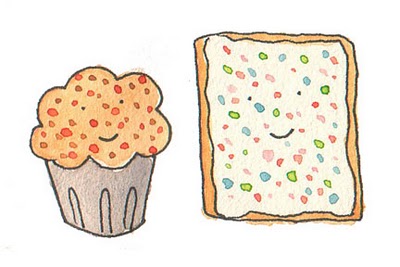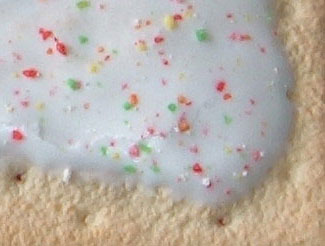 Pop Tarts. Whether you love or hate them, you really can't deny their presence: from those memorable toaster strudel commercials of yore to their ubiquity in office vending machines, they're nothing if not constant in our everyday lives.
Pop Tarts. Whether you love or hate them, you really can't deny their presence: from those memorable toaster strudel commercials of yore to their ubiquity in office vending machines, they're nothing if not constant in our everyday lives.
But how did these little toaster treats worm their way into our lives? For those of you have ever wondered (surely there must be some of you), Cakespy has done some serious sleuthing on the story of the Pop-Tart. We would have been sunk without wonderful reference guides such as Whole Pop Magazine's "True History of Pop-Tarts", Dave Barry's informative article "Tarts Afire", and James Prichard's article on the treats in the Detroit News from 2003.
 Pop-tarts were invented in the post-World War II era, when Post (not Kellogg!) was developing new products. There was an emphasis at this time on foods that were convenient and had a long shelf life, and the now-familiar foil packaging was originally used as a way of preserving a type of moist dog food; they altered it slightly to accommodate a new people-food addition meant to supplement their cereal offerings, which they called "Country Squares". Unfortunately, loose-lipped employees revealed the nature of the product in development before it was released, thus giving arch rival Kellogg a chance to come up with a competitor product--and obviously to think of a better name. The fate of Country Squares? Well, all we can say is, when is the last time you saw one at your local grocery store? Pop-Tarts, on the other hand, were a runaway success.
Pop-tarts were invented in the post-World War II era, when Post (not Kellogg!) was developing new products. There was an emphasis at this time on foods that were convenient and had a long shelf life, and the now-familiar foil packaging was originally used as a way of preserving a type of moist dog food; they altered it slightly to accommodate a new people-food addition meant to supplement their cereal offerings, which they called "Country Squares". Unfortunately, loose-lipped employees revealed the nature of the product in development before it was released, thus giving arch rival Kellogg a chance to come up with a competitor product--and obviously to think of a better name. The fate of Country Squares? Well, all we can say is, when is the last time you saw one at your local grocery store? Pop-Tarts, on the other hand, were a runaway success.
The original Pop-Tarts were unfrosted; some fool thought that the frosting might melt and cause problems in the toaster. Happily they worked on the issue, developing a frosted and toaster-safe version in 1967. Since then, it's been a movie montage-esque development of new flavors and variations, from the most excellent S'more Pop-Tart to the bad-decision neon-colored Wild! Berry. Of course, Pop-Tarts haven't been without their fair share of controversy; but even in spite of the infamous UK toaster cloggings of the early 90's (turns out their toasters are different from ours) and the 1992 toaster fire debacle and even the ill-fated addition of "Go-Tarts" (slender Pop-Tart sticks meant for on-the-go consumption; we say, just eat a Pop-Tart), they've remained a beloved part of not only our lives but our culture.
And happily, Cake Gumshoe Kristin recently came across a wonderful recipe in a Martha Stewart holiday baking guide by Flour Bakery's owner / head baker Joanne Chang, which is reminiscent of the classic toaster treats, but made with more refined tastes in mind...kind of like Pop-Tarts, all growed up.
Tasty Toaster Tarts Recipe by Joanne Chang, owner of Flour Bakery
Pastry
2 cups flour (they recommend King Arthur unbleached all-purpose flour)
1 tbsp sugar
1 tbsp salt
1 cup, 8 oz unsalted butter, cut into pats
Filling: 3/4 cup raspberry jam
1 tbsp cornstarch, mixed with 1tbsp cold water
1 egg, to brush on dough
Topping
1 cup, 4 oz confectioner's sugar
3 to 4 tbsp water
----------
To make dough: Whisk together flour, sugar and salt. Work in butter until mixture holds together when you squeeze it, with pecan-sized lumps of butter still visible. Mix egg and milk, and add it to the dough, mixing just until everything is cohesive.
Divide dough in half, and shape each half into a rough 3x5 inch rectangle, smoothing edges. Wrap in plastic, and refrigerate for 1 hour or up to 2 days.
To make filling: in a small saucepan, mix jam with cornstarch and water mix. Bring mixture to a boil, and simmer, stirring, for 2 minutes. Remove from heat and set aside to cool.
To assemble tarts: remove dough from the refrigerator, and if it's been chilling for longer than 1 hour, allow it to soften and become workable, about 15 to 30 minutes. Place one pice on a lightly floured work surface,
and roll it into a rectangle about 1/8 inch thick, large enough so that you can trim it to an even 9x12 inches. Set aside. Roll a second piece of dough as you did the first. Press the edge of a ruler into the dough you've
rolled, to gently score it in thirds lenghtwise and widthewise; you'll see nine 3x4 inch rectangles.
Beat egg, and brush it over entire surface of dough. Place a heaping tablespoon of jam into center of each marked rectangle. Place second sheet of dough atop first, using your fingertips to press firmly around each
pocket of jam, sealing the dough well on all sides. Cut dough evenly in between jam pockets to make nine tarts. Gently place tarts on a lightly greased or parchment lined baking sheet, and refrigerate, covered, for 30
minutes, to relax and chill the dough.
Prick the top of each tart several times with ha fork. Bake tarts in a preheatd 350 degree oven for 35-40 minutes, until golden brown. Remove from oven, and allow to cool on pan.
For the topping: Combine confectioners sugar with 3 tablespoons of water, adding more if necessary to make a pourable glaze. Pour and spread glaze over cooled tarts. Yield: 9 toaster tarts.
Bonus Pop-Tart Trivia: For the 35th anniversary of the toaster pastry, Kellogg made the biggest Pop-Tart ever recorded: In total, it took more than 545 pounds of flour, 495 pounds of fruit filling, 800 pounds of icing and 150 pounds of colored sprinkles to create the giant-sized toaster pastry. The oversized snack was unveiled at a press conference in front of the famed Madison Square Garden in New York City, where morning commuters were treated to tasting this record-breaking creation.
For more information on Pop-Tarts, visit poptarts.com.
